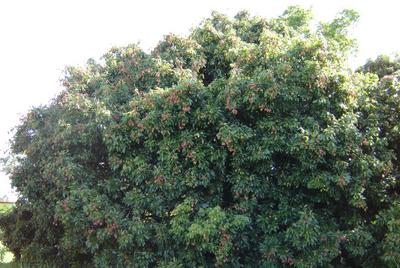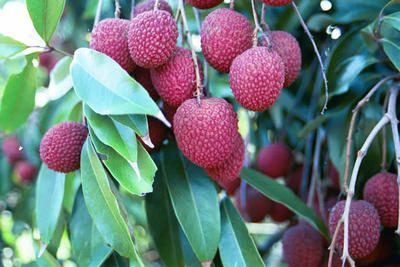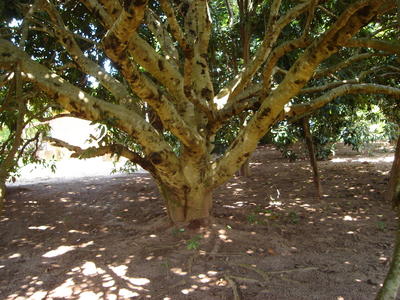Refreshing shadow!
Photo by Sonia de Amorim Mascaro
Flora and Fruits
Photo by Sonia de Amorim Mascaro
I have in my orchard many fruit trees. First of all I will exhibit my gorgeous Lychee tree. The Lychee tree was a gift from our friend many years ago. We have two handsome and dense trees in our orchard. Every year, in December, we are blessed by its delicious fruits. Once you peel the skin off, the juicy flesh is white or pinkish, translucent and glossy like the consistency of a grape, but the taste is sweeter. “Lychees have a sub acid sweet taste and have a wonderful freshness to them that is hard to describe. Lychee fruit is high in the antioxidant Vitamin C and the essential mineral Potassium.”
Origin: “Lychee (lē'chē) , originated over 2000 years ago, is a Chinese tree (Litchi chinensis) of the family Sapindaceae (soapberry family), having a small, aromatic, pulpy fruit in a thin, rough shell. The lychee is native to low elevations of the provinces of Kwangtung and Fukien in southern China, where it flourishes especially along rivers and near the seacoast. It is the best-known Chinese fruit and a favorite with the Chinese, who use it fresh, dried, or preserved. The tree is now grown in other warm countries. Among variant spellings are leechee, lichee, and lychee. Litchis are classified in the division Magnoliophyta, class Magnoliopsida, order Sapindales, family Sapindaceae”.
Description: The Lychee trees are beautiful hardwoods that can grow 20 to 40 feet tall in a primarily dome shaped habit of growth with dense, evergreen leaves. “The Lychee is, all over the world, considered as the "queen of the fruits" due to the delicacy of its appearance and flavor. Although it was only recently that it started to have economical importance in Brazil, the Lychee is already calling the attention of numerous farmers, mainly those who cultivate citric fruits and/or sugarcane in the State of São Paulo.”
Propagation: “Lychee propagation from seed is unsatisfactory because cultivars do not reproduce true from seed. Seedling trees often take 10 years or more to come into bearing. Lychee seeds are short-lived, losing viability after a few days, and are best planted fresh from the fruit. They should not be refrigerated, because this rapidly destroys viability. The most common method of propagating lychee is air-layering, a technique for inducing a branch to form roots while still attached to the tree, after which it is removed and planted. Air-layering is done when leaves of the previous growth flush have matured. Air-layered trees usually take three to five years from planting to become established and begin bearing.”
Adaptation: “Lychees require seasonal temperature variations for best flowering and fruiting. Warm, humid summers are best for flowering and fruit development, and a certain amount of winter chilling is necessary for flower bud development. Lychees need full sun, but young trees must be protected from heat, frost and high winds.”
In my next post, I will introduce my beautiful Jaboticaba tree, native to the Minas Gerais, region of Brazil. The delicious Jaboticaba is perhaps the most popular native fruit-bearers of Brazil.








love lychees! but i've never seen the tree or them growing so thank you for sharing. just found you via peasoup.
ReplyDeleteI feel like I've had the blessing of a whole botany lesson right in your blog! Thanks for sharing so much information about these beautiful trees! They're gorgeous - and so is your puppy!
ReplyDeleteBeautiful tree. I love the colour of the Lychee fruits as they grow.
ReplyDeleteLook forward to learning more about your Orchard.
Hello, Sonia, Thank you for introducing me to the Lychee tree--what a wonderful tree & beautiful orchard. I look forward to learning more of what you are growing! It is a great escape from New England.
ReplyDeletethat was very informative. I had to admit I'd never heard of the tree or the fruit. Looks gorgeous
ReplyDeleteI adore lychees as well - they're one of my favourite fruits. One of the great things about summer in tropical Australia is all the exotic fruits we have - and lychees are at the top of my list. I think the flavour is really delicate - sweet, yet fragrant. I dare anyone to try a lychee and say they don't like it (but that doesn't include the ones in tins soaked in sugary syrup).
ReplyDeleteNow all you need is a "vanilla-icecream tree" growing next to your wonderful lychee tree!
ReplyDeleteTo my mind the perfect combination.
Sonia, I have never eaten lychees, but they are a beautiful fruit, at least in your photo.
ReplyDeleteGreat, informative post. I've heard about lychees and the delicious fruit and beautiful tree, but I had not ever seen them. How wonderful that you have such a tree in your yard. Delicious!
ReplyDeleteHi Sonia. Your nature is very different from mine :-) I am just back home after an early morning walk in my frosty forest (will post photos on my blog later) and will now prepare a huge pot of hot meat soup for lunch.
ReplyDeleteI've never had a lychee before and I doubt that a tree would grow in our mountains, but when I am in the grocery store and I see a lychee--I will buy one and think of you.
ReplyDeleteSo much fun to read your blog and learning about your home and country. I love your photos ...
ReplyDeleteLychee fruit is very beautiful. Nice pictures!
ReplyDeleteBeautiful photos and so much interesting information--a wonderful combination! : )
ReplyDeleteYour photographs become increasingly beautiful. Cheer.
ReplyDeleteWhat beautiful flowers and trees you have in Brazil! Your gardens are beautiful, and the photos gorgeous. Looks like you live in Paradise to me!
ReplyDeleteI just saw a television program about lychees but they're quite expensive here in Australia - $20/kg. But after your post, perhaps I'll dig deep in my pocket and try them!
ReplyDeleteHi Sonia! Thanks for stopping by my site today. The fruit I mentioned does look and resemble a lychee, I think it is also from the same family. It's called a Rambutan, but the shell was actually rather easy to peel back away from the fruit itself. I've never seen a lychee tree myself, yours was just beautiful!! I enjoyed reading about the fruit over here, as well.
ReplyDeleteTake care!!
Sonia
ReplyDeleteAlém de serem bonitas as fotos...fala sério, as frutas são deliciosas,nâo?
Bjs..
Sonia novaes
Wow, that's funny to see lychees growing outside of Asia - anything is possible!
ReplyDeleteThe lychee seed is to use for planting? Sorry for stupid question but dont have any idea how to can grow this sweet fruits. . I love lychee so much when I see your photo o fallen for it. Planning to grow my own lychee tree. Even got 2 tree maybe i be the happiest already. Heheehe
ReplyDeleteThe lychee seed is to use for planting? Sorry for stupid question but dont have any idea how to can grow this sweet fruits. . I love lychee so much when I see your photo o fallen for it. Planning to grow my own lychee tree. Even got 2 tree maybe i be the happiest already. Heheehe
ReplyDelete